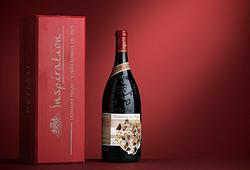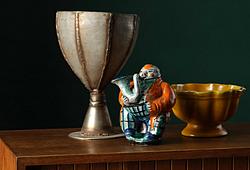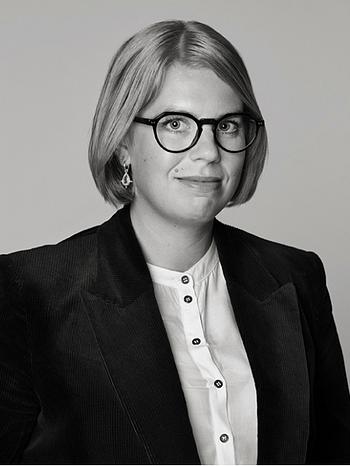Amédée Ozenfant
"Nature morte"
Signed Ozenfant. Executed 1929. Canvas 55 x 46 cm. A certificate of authenticity executed by Pierre Guénégan, author of "Amédée Ozenfant (1886-1966): Catalogue raisonné de l'oeuvre peint" is included with the lot.
Alkuperä - Provenienssi
The artist Erik Olson.
Viveka Bosson, daughter of Erik Olson.
Private collection.
Kirjallisuus
Pierre Guénégan, "Amédée Ozenfant (1886-1966): Catalogue raisonné de l'oeuvre peint", listed as no. 1929/002, p. 419.
Muut tiedot
“Simplification, distortion of forms, and modifications of natural appearances, are ways of arriving at intense expressiveness of form” – Amédée Ozenfant
In the 1920s, the father of Purism, Amédée Ozenfant, completed a number of stripped down still lives derived from the composition featured in our auction, with three vases in the centre (see, for example, ”The Vases”, 1925, at MoMA). In this composition, a wine glass and cocktail glass have been added at each corner. The reddish-brown tones of the vases are in elegant contrast to the two different warm greys of the background.
Amédée Ozenfant was born on the 15th of April 1886 in Saint-Quentin in France. He started painting in his teens and in 1907 enrolled at the Académie de la Palette in Paris, where he studied under Jacques Émile Blanche. In 1908, he started to exhibit at the Salon de la Société Nationale des Beaux-Arts and had an exhibition at the Salon d'Automne two years later.
Between 1909 and 1913, Ozenfant travelled in Russia, Italy, Belgium and the Netherlands and attended lectures at the Collège de France in Paris. In 1915, during the First World War, he founded the magazine L'Élan in Paris with Max Jacob and Guillaume Apollinaire, later becoming its editor. The magazine was associated with Dadaism and here Ozenfant’s theories of a purism of art started to take shape.
In 1917, Ozenfant pursued a new creative direction; a development of Cubism, which emphasised order and precision and which he himself termed ‘Purism’. In the following year, he worked with architect Charles Edouard Jeanneret (Le Corbusier) to formulate the theory of Purism, presenting its main concept in their manifesto ”Après le Cubisme” (After Cubism) published in 1918. With Cubism as their starting point, they painted severely simplified still lives, concentrating on the fundamental form of the objects depicted. Objects were represented by elemental shapes without details. The publication of the manifesto coincided with the first Purist exhibition at Galerie Thomas in Paris in 1918, where Ozenfant displayed his Purist works for the first time. As a movement, Purism was active between 1918 and 1925 and was reflected both in painting and architecture.
In the 1920s, Ozenfant taught with Fernand Léger at the Académie Moderne in Paris, a school with a large number of Swedish students, including members of the Halmstad Group such as Erik and Axel Olson, Waldemar Lorentzon, Otto G Carlsund amongst others. The painting included in our auction was in the collection of Erik Olson at one time.
In 1938, Amédée Ozenfant moved to New York, following a period in London where he started his own art school. The Ozenfant School of Fine Arts ran between 1939 and 1955. Ozenfant became a US citizen in 1944, teaching and lecturing extensively across the USA until 1955. He then returned to France, where he remained for the rest of his life, dying in Cannes in 1966.
Today, Amédée Ozenfant’s works are found in the collections of the Solomon R. Guggenheim Museum in New York, the National Gallery of Art in Washington, D.C., and the Tate Gallery in London, Moderna Museet in Stockholm, Centre Pompidou etc


































































